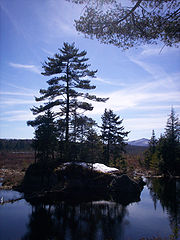
Adirondack Park Visitor Information Center
Encyclopedia

The Newcomb interpretive center was taken over by the State University of NY, College of Environmental Science and Forestry (ESF) on July 1st, 2010 with program responsibility beginning January 1st, 2011. The Newcomb interpretive center is situated on ESF's Huntington Wildlife Forest, a 15000 acres (60.7 km²) biological field station the college has operated in Newcomb since 1932, and also home to the College's Adirondack Ecological Center. ESF is committed to maintaining and expanding the interpretive center as a public resource for education and recreation.
Paul Smiths College (PSC) is currently exploring a mechanism for taking over and managing the interpretive center on PSC's property, and continuing its legacy of education and recreation as well.
The interpretive centers were designed to introduce visitors to the special features of the Adirondack Park, which, at six million acres (24,000 km²), is the largest park in the lower 48 United States. The centers help orient visitors to the park via educational programs, exhibits, and interpretive trails. Educational programs are available for school groups as well as the general public. The buildings are open Tuesdays through Saturdays, 9:00 AM – 5:00 PM, and are closed Thanksgiving and Christmas. The trails are open daily year round from dawn to dusk.
The Paul Smiths center opened in 1989. Located on approximately 2,700 acres (11 km2) near Paul Smiths College, the PSIC has approximately six miles of interpretive trails and eight miles (13 km) of backcountry trails. Throughout the property visitors will encounter every habitat type found in the Adirondack Park except alpine. Historically, each spring the center hosts the Great Adirondack Birding Festival. Throughout the year visitors can partake of guided interpretive walks, regular outdoor activities, naturalist-led canoe paddles on Barnum Pond, and assorted lectures and slide presentations. In the winter the trails are open for snowshoeing and cross-country skiing.
The Newcomb center opened in 1990. Located on 236 acres (0.96 km2) at the outlet of Rich Lake, the center has approximately three and a half miles of interpretive trails. Habitats include lakeshore, wetlands, old growth forest, and mixed northern forest. Throughout the year you can join staff on naturalist-led trail walks, guided paddles on Rich Lake, and assorted workshops and lectures. All trails are open in the winter for snowshoeing; cross-country skiing is allowed on one and a half trails.

